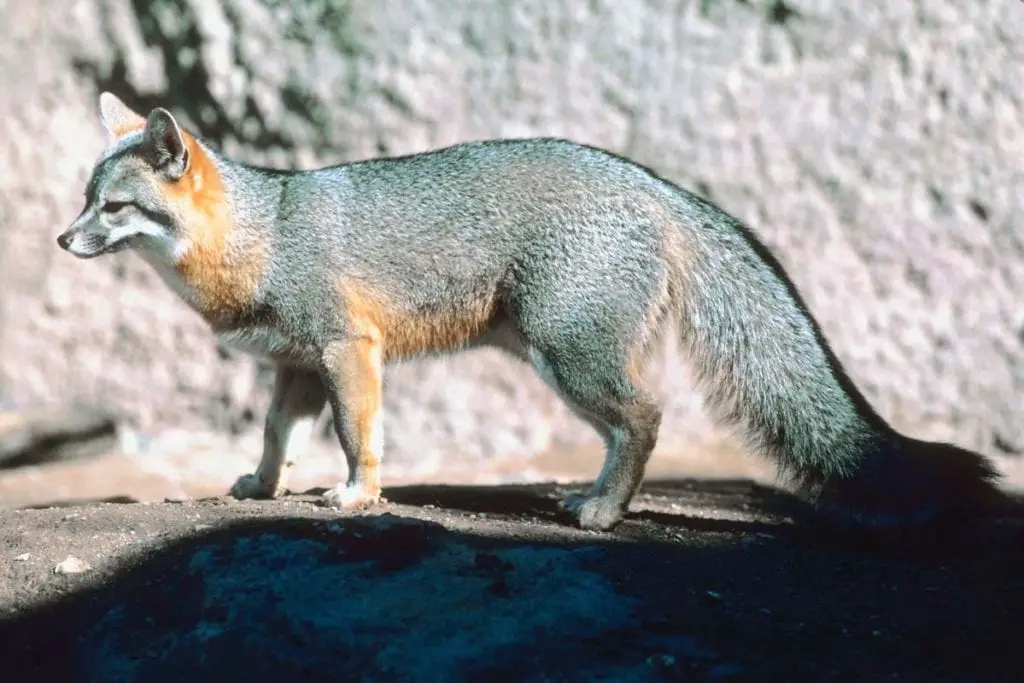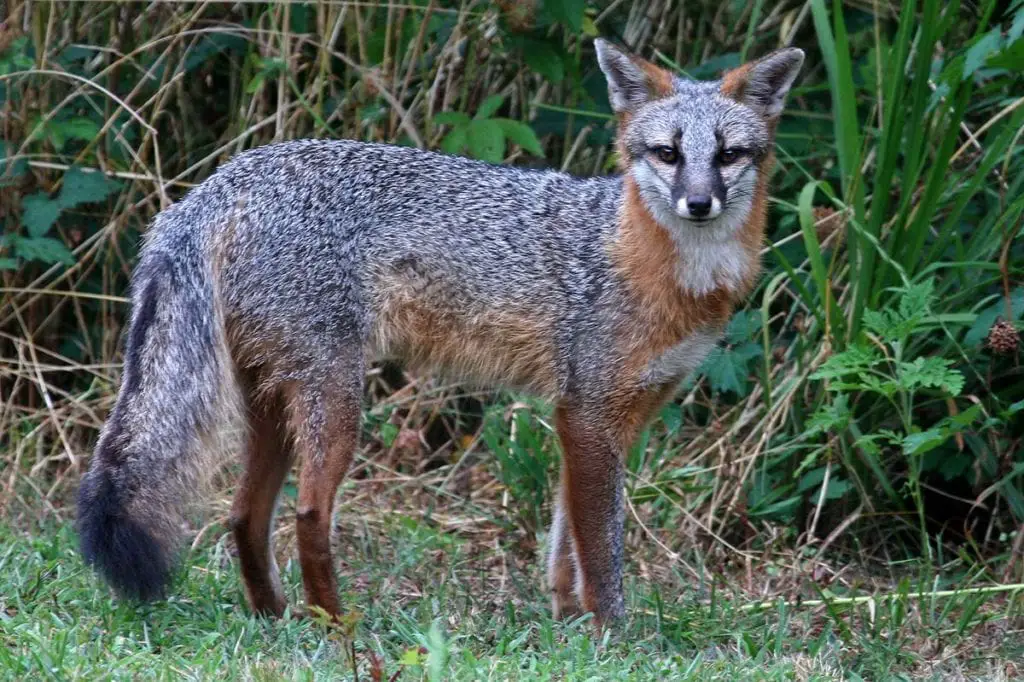There are over 30 species of foxes and all of them have things that make each one of them unique. The gray fox is no exception. Gray foxes have different colorations than red foxes and desert foxes and they prefer to live in regions that have more trees and brush.
Gray Fox
The gray fox (Urocyon cinereoargenteus) is a species of fox found in North and South America. They have salt and pepper colored fur with patches of white and orange around their faces. A gray fox is 10-15 pounds and is 3 ft long.
Gray Fox Video
If you look closely in the thick brush in a wooded area you may be lucky enough to spot a gray fox. Their gray, black, white, and orange colors make them blend in well with their surroundings. While other species of foxes rely on their speed to get away from predators, gray foxes are better at hiding and blending in.
Gray Foxes Status
| Scientific name: Urocyon cinereoargenteus |
| Endangered: No endangered status |
| Regions: North America, South America |
The gray fox is not one of the 12 true type foxes and has many different characteristics and behaviors than some of their other fox relatives. They are a little smaller than some red foxes but still bigger than fennec foxes and other smaller species.
They are also known as:
- Tree foxes
- Grey foxes
- Maned foxes
- Common gray foxes
Because they are found in a few different regions they go by different names. In North America, they are mostly known as the common gray fox but in other regions, they are called tree foxes and maned foxes.
While gray foxes are not native in Europe and England the spelling of “grey fox” comes from the European spelling for the species.

Where Do Gray Foxes Live?
Gray foxes live in North America and the northern parts of South America. You can find them in parts of southern Canada and as far south as Venezuela in South America. The United States are home to a large population of gray foxes, they can be found in many states in America.
At one time gray foxes were the most populated foxes in North America, however, red foxes crossed into North America and began to expand further south, outnumbering gray foxes in their home region.
Even though you can find gray foxes in some of the most southern parts of Canada, they seem to be absent from the northern mountain regions of the United States.
They can be found in many parts of southwestern California and up to northern California near Baja. They have expanded into areas in the United States where they were once extirpated, such as Michigan, Kansas, Oklahoma, and Iowa. In Canada, they can be found in the southern regions of Manitoba and Ontario.
The gray fox can even be found in South America and some parts of Central America such as Colombia and Venezuela.

Gray Foxes Habitats
When it comes to habitats gray foxes prefer areas that have trees, shrubs, and bushes. Forests are a great ecosystem for them because it has everything they need to survive, trees for climbing, bushes for camouflage, and plenty of small game and vegetation to eat on.
They also prefer rocky areas with lots of shrubs. Their fur has a salt and pepper-like gray color that helps them blend into the trees and heavily wooded landscape.
Gray foxes love to climb trees, for this reason, they are called the tree fox. They have also been known to sleep in trees. This is unique because they are the only known canine that has partially retractable claws that allow them to climb.
They have also been known to be found in farmlands, abandoned fields, and some coastal bluffs, however, they prefer thickly wooded areas and dense forests. Gray foxes build their dens in the ground where they raise their kits.

The Gray Foxes Behavior
Gray foxes exhibit a little bit of different behavior than red foxes. They are much more solitary than some other species of foxes. They hide and rarely are seen in the daylight. Foxes are nocturnal hunters and while you may see them in open areas while they are hunting, they mostly stay in areas where they have plenty of cover.
They tend to be seen only in the night, or at dawn or dusk, while staying in their thick wooded burrows and hollow trees during the daylight hours.
They rely heavily on their ability to blend in and stay still. This helps them avoid detection from predators and other threats such as humans. They tend to stay away from areas with heavy human activity and are not very social when it comes to other animals and people.
It is thought by the scientific community that gray foxes are monogamous and that they stay paired for life with those they mate with. They tend to have large family units, with some of the females and even some males staying together from previous litters.

Can Gray Foxes Climb Trees?
This is probably the most fascinating things bout gray foxes. As mentioned before the gray fox has partially retractable claws that allow them to climb trees. This earned them the name tree foxes in some regions and sometimes they can be photographed in the daylight hours sleeping up in tree branches or in hollowed out parts of trees.
They are the only canine that has the ability to fully climb trees, while you may see a few other foxes that can jump into lower parts of trees, only the gray fox can use their claws to climb high into a tree.
Because their claws are so sharp they can climb up rocks, trees, and even rooftops. They can also rotate their forearms and twist their bodies, allowing them to make their way higher up in a tree.
They are very cat-like, sometimes they are even mistaken for large cats while sleeping in trees since they share a lot of the same behaviors and physical abilities.
How Gray Foxes Communicate
Much like other foxes, gray foxes have many vocalizations that they use for different purposes. They screech, they yelp, they howl and they scream. Fox calls are an amazing thing if you have never heard them, late at night when they come out for hunting in the wilderness they can be heard calling out to each other.
Some of their vocalizations are used to warn their families of dangers that they have spotted or to let others know they are nearby.
Females will often call out to the male foxes while they are pregnant or with cubs if they do not come home with a kill quickly, as if to say, we’re hungry!
They have also been known to use their tails to communicate, by stiffening them up or pointing them when they are startled or when danger is near. This is a clue for other family members in the areas that they should be on alert.
Foxes also use urine to communicate, this is called chemical communication. They mark their territories and will mark spots where they have made multiple kills so they know that it is a good place to return to for another meal.

Gray Fox Babies
Baby foxes are known as kits. Gray foxes usually have a litter of around 4 kits. Their gestation period is around 2 months. They usually mate around February or March and have their babies at the end of April or early May.
The kits are a dark color when they come out, much like their parents they will already have a gray or pepper-like appearance. As they get a few months older they start to get white fur on their underbellies and a small amount of orange fur on their face.
Male gray foxes usually stay with their parents until they reach sexual maturity at around 10 months. Sometimes the females will hang around and help raise the next year’s litter before they move on, and even some males will stay with the family or make their own families nearby.
Gray foxes live much longer in the wild than other foxes, usually up to about 12-16 years and can live up to 20 years in captivity with the right care and environment. Their survival in the wild is due in part to their stealthiness and ability to hide from predators as well as their solitary behavior that keeps them from most human populations.

Colors of Gray Foxes
Gray foxes do not have as many color morphs as red foxes. They usually retain their salt and pepper-like appearance. When they start to molt their fur in the warm months they may turn a more blended color of gray.
They have white and orange underbellies, white patches on their chests and some white and orange on their faces but their body is mostly a gray color. The legs are usually an orange color and they have a black stripe on the top of their long tail.
The name of the gray fox species (cinereoargenteus) means “ashen silver” for their gray coats.
The Gray Foxes Tail
The tail of the gray fox is one way to identify them since they are black-tipped. Some other foxes, such as red foxes, have different color morphs making it hard to tell them apart from gray foxes since they become a pepper-like color as well when they molt their fur.
Most red foxes no matter what their color morph looks like, have a white-tipped tail which makes it easier to tell the two apart.
The gray foxes tail is usually large and bushy with gray, black, and some orange. The blacktip and black stripe is their own unique pattern. They will often crouch down low with their tail wrapped to their sides, making them almost look cat-like.

How Big Are Gray Foxes?
Gray foxes are a medium-sized fox. They are not quite as big as some larger red foxes and are usually much shorter. They are about 3 ft long and weigh between 10-15 pounds.
They are not the smallest fox either, some other species such as the fennec fox weigh in at only 2-3 pounds!
Their small stature allows them to crouch down low when hiding and they can also run up 20 miles per hour.
This also makes it easier for them to climb into trees and into the hollow parts of trees for sleeping and for hiding from predators.
What do Gray Foxes Eat?
Gray foxes are omnivores that eat from a variety of small game such as rodents, rabbits, and pheasants. They also eat insects, grubs, worms, and vegetation such as roots, and berries. Foxes are opportunistic feeders and will forage for vegetation when they do not make a kill.
They will sometimes feed on carrion, which are carcasses that other animals have killed and left behind.
The gray fox will sometimes bury their kill, mark the area with urine and return to it later for more feasting.
They hunt for their families when the females are pregnant and primarily hunt at night or during dusk and dawn.
Gray fox kits will begin to forage for themselves after around 4 months, around then they will learn to hunt for themselves and make their first kills.
During the spring and fall months, they will forage on vegetation and fruits, such as dewberries, and elderberries.

Gray Fox Vs Red Fox
- Red foxes tend to be larger, up to 30 pounds, while gray foxes only get up to around 20 pounds.
- Gray foxes have black-tipped tails while red foxes have white-tipped tails, gray foxes also have a black stripe down their tail.
- The gray fox can climb better than the red fox because its claws are retractable and hooked, while red foxes are not.
- Red foxes can run faster than gray foxes, mostly because they are larger, red foxes can run over 30 mph while gray foxes run around 15-20 mph.
There are many differences between the two since they came from different regions. The gray fox seems to have different traits than a lot of other foxes, due to the fact that scientists claim they were originally isolated, possibly on an island and moved to the mainland after.
Gray foxes have round pupils instead of vertical, this sets them apart from red foxes and most all other foxes.
Predators of the Gray Fox
The gray fox has some of the usual suspects when it comes to predators. They are preyed on by animals like coyotes, large raptor birds, badgers and other animals that share their territory.
They don’t have some of the mountainous predators that other foxes have such as mountain lions and bears because the gray fox is absent from most mountain regions.
That doesn’t mean that a bear or bobcat won’t venture into their territories and cross paths either, it does happen.
Gray foxes are great at hiding and blending in with their surroundings. They also tend to stay away from human developments. They live longer lives because of this and avoid predation in some cases.
Humans who are trying to remove them from a location will oftentimes use fire, burning brush and trees to get rid of their habitats, forcing them to move to different territories.

Check out our PAWSOME new collection of Fox Gifts
See more about fox habitats.
Related Questions
Can gray foxes swim? Gray foxes are great swimmers, they are medium-sized foxes which lets them gracefully move around in the water. It is speculated that they were once isolated and possibly lived on an island off of California, which could explain why they are so different from other foxes, biologically and physically.
Are gray foxes related to island foxes? Island foxes are closely related to gray foxes are of the same genus (Urocyon) the Urocyon are considered to be one of the oldest and most primitive of the living canids and were once the most common of foxes.

